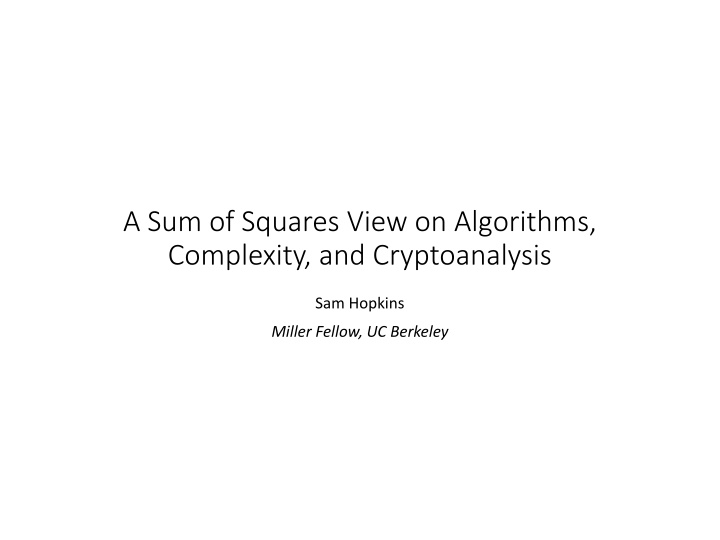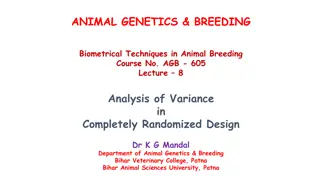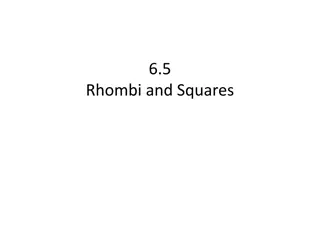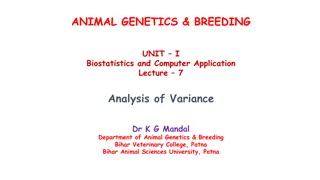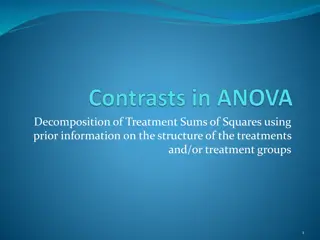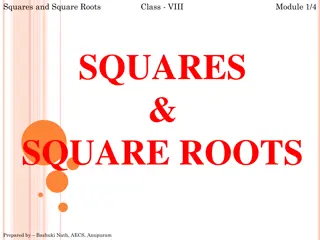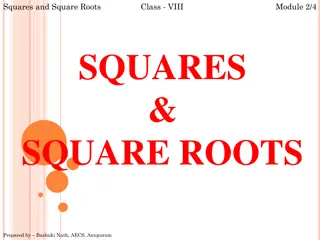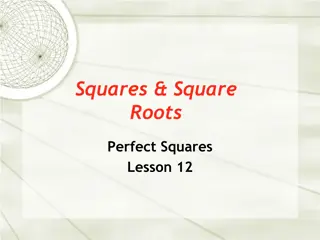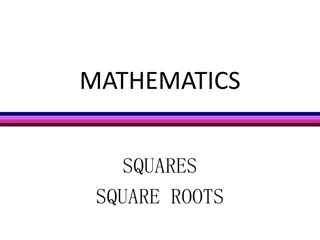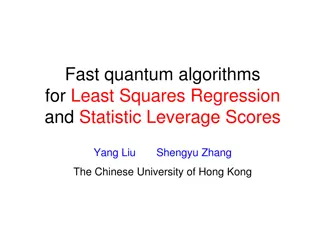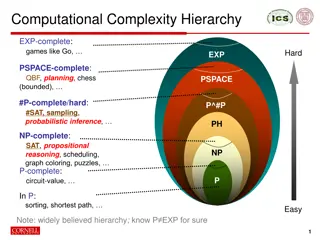A Sum of Squares View on Algorithms, Complexity, and Cryptoanalysis
This content delves into the Sum of Squares approach, offering a unique perspective on algorithms, complexity theory, and cryptoanalysis. It explores the practical applications, success stories, lower bound achievements, and its role in cryptography. Discover how Sum of Squares provides a powerful framework for algorithm design and analysis, showcasing its impact on various challenging problems in computing and beyond.
Download Presentation

Please find below an Image/Link to download the presentation.
The content on the website is provided AS IS for your information and personal use only. It may not be sold, licensed, or shared on other websites without obtaining consent from the author.If you encounter any issues during the download, it is possible that the publisher has removed the file from their server.
You are allowed to download the files provided on this website for personal or commercial use, subject to the condition that they are used lawfully. All files are the property of their respective owners.
The content on the website is provided AS IS for your information and personal use only. It may not be sold, licensed, or shared on other websites without obtaining consent from the author.
E N D
Presentation Transcript
A Sum of Squares View on Algorithms, Complexity, and Cryptoanalysis Sam Hopkins Miller Fellow, UC Berkeley
What is Sum of Squares? Prosaic view A family of convex relaxations for polynomial optimization problems Glamorous view Optimal meta-algorithm offering new lens on algorithms and complexity
What is Sum of Squares? Today s view A language, toolkit, and set of abstractions for algorithm design with convex programming, enabling rigorous analysis of a particular set of powerful convex programs.
Huge Algorithmic Success Offers best known poly-time algos for: Constraint satisfaction Cut problems (sparsest cut, min cut, ) Khot s unique games Tensor problems (higher-order linear algebra) Robust/heavy-tailed statistics (statistics with nasty data) High-dimensional clustering Matrix completion/Netflix problem Sparse PCA, finding hidden sparse vectors Community detection Best separable state (detecting quantum entanglement) The list just keeps growing!
Growing Lower Bound Success Can prove unconditional lower bounds to support existing hardness results and/or to support hardness conjectures. Strong lower bounds known in support of: Feige s random-SAT hypothesis Planted clique (some more exotic problems)
SoS and Cryptography Cryptoanalysis: SoS is weapon of choice for designing poly-time algorithms for hard combinatorial/analytic problems. (NOT usually algebraic problems.) Justifying assumptions: SoS lower bounds (impossibility results) are evidence for hardness against all polynomial time algorithms.
Starting to Enter the Crypto Scene In 2017-18, several proposals for indistinguishability obfuscation based on blockwise 2-local or degree-2 PRGs [Lin-Tessaro, Ananth-Jain-Sahai, Agrawal, Lin- Matt] Do blockwise 2-local PRGs exist? NO! [BBKK 17], attack via SoS Do degree-2 PRGs exist? All existing proposals largely refuted [BHJKS 19], attack via SoS
Agenda What is sum of squares? Raghavendra s Theorem: evidence for optimality among polynomial time algorithms (in restricted settings) Technical Vignette: solving degree-2 equations
What is Sum of Squares? Today s view A language, toolkit, and set of abstractions for algorithm design with convex programming, enabling rigorous analysis of a particular set of powerful convex programs. Philosophy/Methodology round and relax, identifiability to algorithms, Marley s theorem , Toolkit quadratic sampling, conditioning, global correlation, pseudocalibration, Language pseudodistribution , SoS proof , Linear Programs max flow, compressed sensing, Semidefinite Programs max cut, Netflix problem, Hierarchies Sherali-Adams, SoS
What is Sum of Squares? Today s view A language, toolkit, and set of abstractions for algorithm design with convex programming, enabling rigorous analysis of a particular set of powerful convex programs. Philosophy/Methodology round and relax, identifiability to algorithms, Marley s theorem , Toolkit quadratic sampling, conditioning, global correlation, pseudocalibration, Language pseudodistribution , SoS proof , Linear Programs max flow, compressed sensing, Semidefinite Programs max cut, Netflix problem, Hierarchies Sherali-Adams, SoS
Convex Programming Convex set Non-convex set Can find a point in and minimize a convex function over any sufficiently simple convex set in polynomial time. Extremely useful in algorithm design
Which convex sets? Polytopes a.k.a. LPs Max flow ? ??,?? 0 ? = ?1,?2, ,?? Single pixel camera
Beyond Polytopes: Semidefinite Programs (SDP) Max Cut Given graph G, find subset of nodes cutting most edges. Random cut: cuts of edges ( 1/2-approximation ) ? ?? ?,? 0,?? ? = 1 (all eigenvalues real, nonegative, sum to 1) ?11 ?21 ?31 ?12 ?22 ?32 ?13 ?23 ?33 LP: 1 ? = 2 SDP [GW 95]: 0.878 (!!!)
What is Sum of Squares? Today s view A language, toolkit, and set of abstractions for algorithm design with convex programming, enabling rigorous analysis of a particular set of powerful convex programs. Philosophy/Methodology round and relax, identifiability to algorithms, Marley s theorem , Toolkit quadratic sampling, conditioning, global correlation, pseudocalibration, Language pseudodistribution , SoS proof , Linear Programs max flow, compressed sensing, Semidefinite Programs max cut, Netflix problem, Hierarchies Sherali-Adams, SoS
How to design LP/SDP-based algorithms 1. Look at your problem 2. Be extremely clever, invent LP/SDP relaxation 3. Be extremely clever, analyze your relaxation 4. Publish paper
Approximating complex sets by simple ones To approximate max-cut: ? 1,1? Cuts Need to approximate ?? :? 1,1?
Approximating complex sets by simple ones How would you know which constraints to add?
[Shor 87, Nesterov 00, Parillo 00, Lasserre 01] How to choose your SDP? SoS (prosaic): principled way to produce hierarchy of SDP approximations to nasty (nonconvex) sets. Choose your own complexity! And attendant running time (And suffer the consequences/reap the rewards) [Bandeira-Kunisky 18]
Polynomials and SoS Given set defined by polynomial (in)equalities e.g. {?? :?? 2= 1} Degree-? SoS: SDP with ?? variables and constraints increasing strength, increasing complexity And language, toolkit to reason about them
What is Sum of Squares? Today s view A language, toolkit, and set of abstractions for algorithm design with convex programming, enabling rigorous analysis of a particular set of powerful convex programs. Philosophy/Methodology round and relax, identifiability to algorithms, Marley s theorem , Toolkit quadratic sampling, conditioning, global correlation, pseudocalibration, Language pseudodistribution , SoS proof , Linear Programs max flow, compressed sensing, Semidefinite Programs max cut, Netflix problem, Hierarchies Sherali-Adams, SoS
Agenda What is sum of squares? Raghavendra s Theorem (and a little beyond): evidence for optimality among polynomial time algorithms (in restricted settings) Technical Vignette: solving degree-2 equations
Evidence for Optimality 2 kinds of evidence: Soft: subsumes LP, SDP, spectral algorithms captures guarantees of best algs in wide variety of settings (caveat: not algebraic settings) Hard: Raghavendra s theorem
Formalizing optimality: CSPs Constraint satisfaction problem: predicate ? 1? { 1}, variables ?1, ??, clauses ?(?1,?17,?74), etc e.g. 3SAT: ?1 ?3 ?17 ?10 ?5 ?123 Goal: find ? 0,1? to satisfy as many constraints as possible Approximation: ?-approximation algorithm finds ? satisfying ? ??? of the constraints
Raghavendras Theorem Approximating CSPs polynomials. e.g. ?? Approximate nasty set defined by 2= 1 iff ?? { 1}, polynomialize ? Raghavendra 08: Under unique games conjecture, degree-2 SoS is optimal polynomial-time approximation. For every predicate ?, if degree-2 SoS fails to ?-approx. then ? + ? -approximating is NP hard! [Chan 08]: removes reliance on unique games for large subset of CSPs [Lee-Raghavendra-Steurer 15]: SoS is unconditionally optimal among SDPs for CSPs
Agenda What is sum of squares? (with a little advertising) Raghavendra s Theorem (and a little beyond): evidence for optimality among polynomial time algorithms (in restricted settings) Technical Vignette: solving degree-2 equations
Example algorithm: solving systems of quadratic equations Quadratic PRG with polynomial stretch simplification of PRG needed by iO constructions of [Ananth-Jain-Sahai, Agrawal, Lin-Matt] ?1? , ,??? are ?-variable quadratic polys coefficients in [ ?? 1,?? 1] ? ?1+? : polynomial stretch Weak PRG: ??,??? , ??,??? + ?? are indistinguishable for reasonable random ?,??
Natural candidate: random polynomials What if ?1, ,?? are random? Then can invert! Can be sparse or dense! Theorem [BHJKS 19]: Exists poly-time SoS alg s.t. if ?is a nice distribution on quadratic ?-variable polynomials (nonzero, coefficients pairwise indep.) ?1, ,?? ? i.i.d. ? ? log??(1) Then w.h.p. can invert ? {??? }.
Inverting quadratic PRGs by SoS Given: ?1, ,??,?1= ?1? , ??= ??? for some ? ?? 1, ,?? 1 Goal: find ? Nasty set defined by polynomial equations: ? ??? = ?? (Almost) our algorithm: output any point in degree-2 SoS relaxation of ? ??? = ??
Inverting quadratic PRGs by SoS Given: ?1, ,??,?1= ?1? , ??= ??? for some ? ?? 1, ,?? 1 Goal: find ? 2= 1 ? Nasty set defined by polynomial equations: ? ??? = ??, ? 2= 1 Our algorithm: output any point in degree-2 SoS relaxation of ? ??? = ??, ? 2= 1
Inverting degree-2 PRGs by SoS degree-2 SoS relaxation of ? ??? = ??, ?2= 1 define some matrices: ??,?? = ??(?) the SDP: ? ?? ? ??,? = ??,?? ? = ?,? ? contains ?? since ?? ?? = ?2= 1 Extensively studied in literature on matrix sensing, matrix completion, Netflix problem Prior work: if ??,?are incoherent then only feasible ? is ?? . We show: if ?? s i.i.d. from nice distribution, ? random, ? ?, then whp ??,?are incoherent [Gross 09, Recht-Fazel-Parillo 07]
Conclusion Philosophy/Methodology round and relax, identifiability to algorithms, Marley s theorem , Toolkit quadratic sampling, conditioning, global correlation, pseudocalibration, Language pseudodistribution , SoS proof , Linear Programs max flow, compressed sensing, Semidefinite Programs max cut, Netflix problem, Hierarchies Sherali-Adams, SoS SoS is a powerful family of algorithms/tools with broad range of applications Some evidence for optimality among polynomial time algorithms Breaks existing constructions of quadratic PRGs for iO
Thanks! Resources: Barak-Steurer lecture notes: https://www.sumofsquares.org/public/index.html Raghavendra-Schramm-Steurer survey: https://arxiv.org/abs/1807.11419 My thesis: http://www.samuelbhopkins.com/thesis.pdf
Lower Bounds Known: lower bounds in support of major average-case complexity hypotheses -- Feige shypothesis on random SAT [Grigoriev 01, Schoenebeck 08] -- planted clique [Barak-H-Kelner-Kothari-Moitra- Potechen 16]
Example: Planted Clique Distinguish ? ? ?,1 2 from ? ? ?,1 2+ ?-clique. Brute-force: ? log?, ?? log ?time Polynomial time: ? Sudakov 98] ? spectral alg, degree-2 SoS [Alon-Krivlevech- Conjecture: no poly-time alg tolerates ? ? Central conjecture in average-case complexity One-way functions [JP 00], Nash equilibrium [HK 11, ABC 13], sparse principal component analysis [BR 13], compressed sensing [KZ 14],
Example: Planted Clique Evidence for the planted clique conjecture? Gadget reductions make gadget-y instances What about SoS lower bounds? (Caveat: do not know Raghavendra-style optimality for average-case problems)
Example: Planted Clique If ? log?, max clique would distinguish ? ?,1 ? ?,1 2+ ?-clique 2 vs Polynomial optimization formulation of max-clique: 2= ?? max ? ??? s.t. ????= 0 if ? not adj. to ?, ?? Theorem [BHKKMP 16]: Degree ?(log?)SoS relaxation of max-clique on ? ? ?,1 2 has value ? 1 2 ? 1.
Evolution of Convex Programming Linear programming Max flow Compressed sensing
What is Sum of Squares? A specific family of convex programs A language, toolkit, and set of abstractions for algorithm design with convex programming A universal meta-algorithm
notes What is sum of squares? Why is it relevant to cryptographers? Algorithms for cryptoanalysis Lens for hardness Example problems Max cut Raghavendra theorem Planted clique Do an example? What problem? Tensor completion? Solving degree-2 equations? Relation to LPs/SDPs/spectral algorithms Language for semidefinite programming Unification of algorithm design using small set of organizing principles Gives recipe for algorithm design good for cryptoanalysis Meta-algorithms provide framework for hardness
